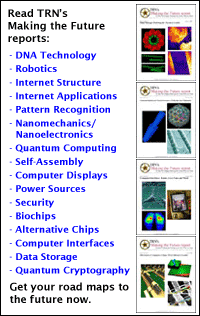
Radio tags give guidance
By
Kimberly Patch,
Technology Research NewsUniversity of Rochester researchers have found a new use for the radio frequency identification tags that manufacturers are aiming to use to track products like cartons of milk and sweaters.
These radio ID tags contain small radio transponders that broadcast unique identification numbers. Radio receivers can monitor the tags to track inventories in real time. The cheap tags make tracking from the factory to the consumer cost-effective; they have also become a source of concern because they could be used to record individuals' movements and purchasing habits.
The Rochester team has reversed the standard radio tag setup by making the receivers mobile and the transponders fixed; the arrangement provides information at certain points in space. "We reversed the usual application of fixed reader and... portable tag to... use fixed tags to let a person know where they are," said Jack Mottley, an associate professor of electrical and computer engineering and adjunct associate professor of biomedical engineering at the University of Rochester.
The system, dubbed Navigational Assistance for the Visually Impaired (NAVI), can provide location information for the visually impaired and for other kinds of navigational assistance applications like self-guided tours.
The system includes a set of permanently mounted passive transponders and a reader/playback device carried by the user. Rather than tipping off an inventory system when a specific item is near, a transponder trips a particular CD track when a playback device comes within range.
The system could be a low-cost alternative to global positioning system-based schemes for providing location-specific information and pedestrian navigational assistance.
For applications for the visually impaired, transponders could be mounted near key points like hallway intersections. For tour applications, transponders would be mounted near items of note, and near places where people might need directions.
Once the passive transponders are installed at key points, "the user will simply turn on the device, make sure the correct CD is installed, and then put on... headphones," said Mottley. "As they pass by the transponder the CD player will turn on and play a particular track -- say track number 3," he said.
If, for example, the application is for the visually impaired, the track might say "front of Rush Rhees library," said Mottley. Rush Rhees is the main library at the University of Rochester.
A CD intended for self-guided tours might have a longer message that gives the history of the building and points out some other items of note near the fašade, then gives directions to enter the library and turn left, said Mottley. As the user continues walking, additional transponders trigger other tracks, he said.
The researchers' initial idea was to use a digital voice recorder like those used in digital answering machines to play the messages. They found that using removable media like CDs was easier, however. The tricky part of putting the system together was combining the identification tracking function used by the radio frequency system with the audio playback portion of the CD system.
The system is made from off-the-shelf parts, and is relatively inexpensive to implement because radio frequency transponders are cheap, simple and durable. They do not contain power supplies, and work even when they are painted.
The researchers' prototype is several times bigger than a portable CD player, but could eventually be close to that size, according to Mottley.
The researchers are looking to improve the prototype with a longer-range tag reader. "We need to achieve about a 2 meter read range," Mottley said.
The system could eventually be used in self-guided tours of places like museums, and as a way to give people directions in complicated and confusing buildings like medical centers, according to Mottley.
The method could be used in commercial products in less than two years, according to Mottley. "The technology is all there and ready to go," he said. Mottley came up with the method along with a group of students: Chris Alden, David Wolpert, Christina Lee, Erica Mazza, Mahbubul Haque, Muhua Pang, and Brian Curran. The research was funded by University of Rochester.
Timeline: > 2 years
Funding: University
TRN Categories: Wireless Communications; Applied Technology
Story Type: News
Related Elements: None
Advertisements:
September 24/October 1, 2003
Page One
Radio tags give guidance
Laser made from single atom
Web searches tap databases
Heated plastic holds proteins
News briefs:
Reflective dust IDs substances
Rapid process shapes aluminum
3D display goes deeper
Artificial DNA stacks metal atoms
Teamed lasers make smaller spots
Glow shows individual DNA
News:
Research News Roundup
Research Watch blog
Features:
View from the High Ground Q&A
How It Works
RSS Feeds:
News
Ad links:
Buy an ad link
| Advertisements:
|
 |
Ad links: Clear History
Buy an ad link
|
TRN
Newswire and Headline Feeds for Web sites
|
© Copyright Technology Research News, LLC 2000-2006. All rights reserved.